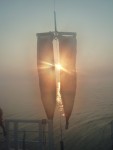Some images from our morning. It’s difficult to keep a camera from fogging up, if it has been sitting in the air conditioned dry lab and is brought out on deck. However it can make for some fun photos effects that are real, not from an iPhone app (though those are pretty cool too).
- Z-Trap deployment at dawn.
- Z-Trap deployment at dawn through the foggy lens. Condensation is a problem with the cameras on these hot humid days.
- The A-Team (night watch) collecting jellyfish eggs from an experiment.
- The A-Team (night watch) collecting jellyfish eggs from an experiment, backlit
- The A-Team (night watch) collecting jellyfish eggs from an experiment, top view.
We often have multiple operations going on during these cruises, and while a few of us were setting the Z-Traps for a 45 minute deployment to see if zooplankton were migrating down from the surface layer, another group stayed up past their bedtime to break down a jellyfish experiment. One of our graduate students is trying to better understand the life cycle of the ctenophore Mnemiopsis leidyi, and a key component is the birth rate, so she is incubating individual adult ctenophores in filtered seawater over night, then collecting that water at dawn to see if there are eggs in it. As you can see, she has help from her watchmates. The eggs are difficult to see until they have been preserved, so we won’t know the numbers until later, but it should tell us something about how fit these animals are. There sure are a lot of them out here.
We are also estimating the abundance of the ctenophores, which eat our target copepod species, Acartia tonsa, and the Z-Trap data will tell us if the Acartia are found in the same depths as the ctenophores, or if they are moving away from the ctenophores. That too will take some time to figure out, after looking through the hundres of samples we generate on each cruise. But pictures are instantaneous, so enjoy.






